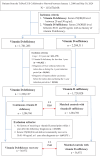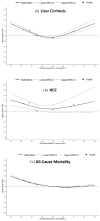Nonlinear associations of serum vitamin D levels with advanced liver disease and mortality: a US Cohort Study
- PMID: 40351383
- PMCID: PMC12062647
- DOI: 10.1177/17562848251338669
Nonlinear associations of serum vitamin D levels with advanced liver disease and mortality: a US Cohort Study
Abstract
Background: Vitamin D deficiency is prevalent and linked to chronic diseases; its association with advanced liver disease progression requires clarification.
Objectives: To investigate the association between vitamin D levels and risks of liver cirrhosis, hepatocellular carcinoma (HCC), and mortality, and assess risk changes after achieving sufficiency post-supplementation.
Design: This was a retrospective cohort study.
Methods: Utilized TriNetX US data (3,905,594 patients, 2000-2024). Adults with vitamin D deficiency (20.00-30.00 ng/mL) were compared with those with sufficient levels (30.01-80.00 ng/mL). Follow-up was initiated from the first vitamin D test or start of supplementation to minimize immortal time bias. Propensity score matching (1:1) balanced >20 baseline confounders.
Results: After matching, 1,204,760 patients with vitamin D deficiency and 1,204,760 with sufficient vitamin D levels were included. Vitamin D deficiency was associated with an increased risk of liver cirrhosis (hazard ratio (HR), 1.30; 95% confidence interval (CI), 1.25-1.36), HCC (HR, 1.22; 95% CI, 1.08-1.37), and all-cause mortality (HR, 1.14; 95% CI, 1.13-1.16). Achieving sufficient vitamin D levels reduced the risk of all-cause mortality (HR, 0.93; 95% CI, 0.88-0.99) and aligned HCC outcomes (HR, 1.16; 95% CI, 0.68-2.00). However, it did not significantly reduce the risk of liver cirrhosis (HR, 2.05; 95% CI, 1.69-2.50). Dose-response analysis showed a U-shaped relationship for liver cirrhosis and HCC, with the lowest risks at 40-60 ng/mL.
Conclusion: Serum vitamin D levels showed a nonlinear association with liver cirrhosis and HCC risk; deficiency independently increased the risks for cirrhosis, HCC, and mortality. Supplementation achieving sufficiency reduced mortality and normalized HCC risk but not cirrhosis risk, potentially reflecting limitations in reversing established disease. The lowest liver disease risk was associated with vitamin D levels of 40-60 ng/mL in this cohort, although causality and the clinical benefit of targeting this specific range require confirmation.
Keywords: hepatocellular carcinoma; liver cirrhosis; mortality; vitamin D deficiency; vitamin D supplementation.
Plain language summary
How vitamin D levels impact liver health and risk of death: a US Study Vitamin D is an important nutrient that our bodies need to stay healthy, but both too little and too much may be harmful. This study explored whether having low vitamin D levels increases the risk of serious liver diseases “such as liver cirrhosis and liver cancer” and the risk of death, and whether improving vitamin D levels can make a difference. Researchers analyzed the health records of millions of adults from various US hospitals between 2000 and 2024. They compared patients with low vitamin D levels to those with normal levels. In addition, they looked at a group of patients who had low vitamin D levels but later improved their levels through supplementation. The study found that people with low vitamin D levels had a higher risk of developing advanced liver diseases and were more likely to die compared to those with normal vitamin D levels. Interestingly, even after improving vitamin D levels, the risk of liver cirrhosis remained high, although the risk of death was reduced and liver cancer risk was similar to those with normal levels. The researchers also discovered that the relationship between vitamin D and liver health was not straightforward both very low and very high vitamin D levels were associated with greater risks, suggesting that an optimal balance is key. In simple terms, maintaining the right amount of vitamin D appears important for protecting liver health and reducing the risk of serious illness and death, although more research is needed to confirm the ideal levels and the benefits of aiming for them.
© The Author(s), 2025.
Conflict of interest statement
The authors declare that there is no conflict of interest.
Figures




Similar articles
-
Vitamin D Deficiency Is Highly Prevalent in Critically Ill Patients and a Risk Factor for Mortality: A Prospective Observational Study Comparing Noncirrhotic Patients and Patients With Cirrhosis.J Intensive Care Med. 2020 Oct;35(10):992-1001. doi: 10.1177/0885066618803844. Epub 2018 Oct 1. J Intensive Care Med. 2020. PMID: 30270710
-
A comprehensive analysis of the impact of smoking on adverse clinical outcomes of steatotic liver diseases.Therap Adv Gastroenterol. 2025 Apr 12;18:17562848251331315. doi: 10.1177/17562848251331315. eCollection 2025. Therap Adv Gastroenterol. 2025. PMID: 40292092 Free PMC article.
-
Severe Vitamin D Deficiency Increases Mortality Among Patients With Liver Cirrhosis Regardless of the Presence of HCC.In Vivo. 2019 Jan-Feb;33(1):177-182. doi: 10.21873/invivo.11456. In Vivo. 2019. PMID: 30587620 Free PMC article.
-
Vitamin D supplementation for sickle cell disease.Cochrane Database Syst Rev. 2020 May 28;5(5):CD010858. doi: 10.1002/14651858.CD010858.pub3. Cochrane Database Syst Rev. 2020. PMID: 32462740 Free PMC article.
-
Vitamin D supplementation for the treatment of COVID-19: a living systematic review.Cochrane Database Syst Rev. 2021 May 24;5(5):CD015043. doi: 10.1002/14651858.CD015043. Cochrane Database Syst Rev. 2021. PMID: 34029377 Free PMC article.
References
-
- Lee P, Eisman JA, Center JR. Vitamin D deficiency in critically ill patients. N Engl J Med 2009; 360(18): 1912–1914. - PubMed
-
- Gasmi A, Bjørklund G, Peana M, et al.. Phosphocalcic metabolism and the role of vitamin D, vitamin K2, and nattokinase supplementation. Crit Rev Food Sci Nutr 2022; 62(25): 7062–7071. - PubMed
LinkOut - more resources
Full Text Sources

